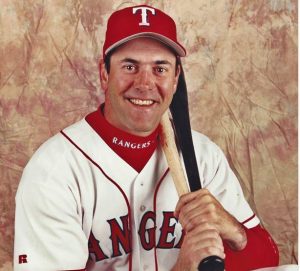Oh, What a Thrill! Will Clark: Career Overview (Part 7)
Part 7: Playing Hurt Deep in the Heart of Texas
This is the seventh in a series of articles that detail the career of New Orleanian Will “The Thrill” Clark. Watch for additional weekly posts about Clark’s career on the Crescent City Sports website. Click here for the full series.
After the 1993 season, Clark took a big step in signing a free agent contract with the Texas Rangers and leaving his heart in San Francisco, the only major-league team he had played for. His last two seasons with the Giants had been subpar for Clark, so the prospect of playing for his new team in a brand-new stadium energized him. The MLB owner’s lockout of the players in August 1994 interrupted Clark’s brilliant first season with the Rangers. Then for the next three seasons Clark had a hard time playing full seasons due to injuries. In 1998 he showed that he could still be effective when healthy, but his star status had diminished by then.
 Clark signed with the Texas Rangers over the winter of 1993 after playing eight seasons in San Francisco Giants. He had been a five-time All-Star with the Giants and helped them to a World Series in 1989. With Texas, he was replacing first-baseman Rafael Palmeiro, who wasn’t re-signed by the Rangers and eventually moved on to Baltimore.
Clark signed with the Texas Rangers over the winter of 1993 after playing eight seasons in San Francisco Giants. He had been a five-time All-Star with the Giants and helped them to a World Series in 1989. With Texas, he was replacing first-baseman Rafael Palmeiro, who wasn’t re-signed by the Rangers and eventually moved on to Baltimore.
The 1994 season was the first for which Major League Baseball moved to the three-division format in each league. The Rangers were in the American League West Division with Oakland, Seattle, and California. They were debuting their new stadium, The Ballpark at Arlington.
With the kind of numbers Palmeiro put up in the previous season, Clark would have some big shoes to fill to make Rangers fans feel like the team had improved. Jose Canseco was coming off a winter when he underwent transplant elbow surgery, so there was concern as to he would bounce back.
Canseco and Clark had a public exchange of contentious words a few years earlier when they were cross-town rivals with the A’s and the Giants. Now as teammates, naturally there was speculation about whether the clubhouse was big enough for the two players with huge personalities. At the time of Clark’s signing in November, Canseco said he didn’t see any problem with Clark stepping in as a leader in the clubhouse. There seemed to be a void in leadership, and Rangers manager Kevin Kennedy welcomed Clark’s presence.
Clark made a good impression with the Rangers from the get-go. After a productive spring training, Clark carried over his hot bat into April, when he hit .395 with three home runs and 20 RBI.
He was having a positive effect on the other players in the lineup. Rangers hitting coach Willie Upshaw said in The Sporting News, “Clark elevated the Rangers’ offense by example, showing his teammates exactly what situational hitting is all about. The other guys have seen him stay within himself game in and game out.”
The Rangers held first place in the division for most of May, although they had never played above .500 since the start of the season. Clark and Canseco were leading the way offensively, and at one point they both had thirty or more consecutive games reaching base successfully. Canseco was making a strong bid for Comeback Player of the Year. Furthermore, it was a season of vindication for Clark, too, as he was able to silence the belief by some that his career was on the decline after his last two seasons with the Giants.
At the All-Star break, Clark was putting up his best season since 1989. His slash line was .353/.449/.571, to go along with 13 home runs and 78 RBI. He was selected to his sixth All-Star team and went 2-for-2 as a substitute for first-base starter Frank Thomas in the All-Star Game.
It seemed like Clark made the transition to the American League look easy. But, in fact, he was unable to leverage his vast library of video tapes of his past at-bats in practically every situation and the copious notes he recorded about every pitcher he faced. He essentially had to start over in familiarizing himself with every American League pitcher, umpire, and ballpark.
The Rangers, with a 42-45 record at the break, remained in first place, three games ahead of the Oakland A’s.
Bothered by a sore right knee, Clark’s performance took a sharp decline after the break. He was no longer getting on base at the same rate as before, and his power was practically non-existent.
But then the bottom dropped out on the entire league, when the MLB owners locked out all the major-league players on August 12 over the players’ disapproval of a salary cap the owners wanted to institute as part a new revenue-sharing plan. The entire rest of the season was cancelled by acting commissioner Bud Selig on September 14, and there was no post-season playoff or World Series.
In his 26 remaining games after the All-Star break, Clark hit only .244 with no home runs and two RBI. He still managed to hit .329 for the season, with 13 home runs and 80 RBI.
In the abbreviated season the Rangers finished in first place in the AL West with a losing record (52-62), recording their first division title in franchise history.
With no resolution to the strike over the winter, spring training in 1995 began with replacement players instead of the regular roster of major-league players. The MLB owners used this tactic to try to apply leverage over the regular players to accept their terms.
Clark worked out in New Orleans as the replacement players reported to the Rangers’ spring site at Port Charlotte, Florida. He commented to the Times-Picayune about the situation, “It’s a crock. We all knew they were going to try to force our hands with replacement players. That’s just part of the process. It worked for the NFL, but I don’t see it working for baseball. The talent level won’t even approach the majors, and it’ll probably be beneath minor-league level.”
Clark was a player representative for the Rangers and sat in meetings where he saw evidence of bickering rather than negotiation. While some players, like the Phillies’ Lenny Dykstra, hinted at crossing the picket line, Clark would have no part. The Times-Picayune reported Clark’s feelings, “No chance of that with me. I’m a fan of baseball, too, in that I know what a lot of people did before me to get in the position I’m in now. I love playing baseball. But I realized a long time ago on this level, it’s a business.”
On March 31, a federal judge issued an injunction against the owners from locking out the players. On April 2 the major-league players returned to work and were given only two weeks to get ready for the start of the regular season on April 26. Jose Canseco had been traded by the Rangers over the winter, and outfielder Juan Gonzalez started the season on the disabled list. So the Rangers looked to Clark and designated hitter Mickey Tettleton to provide the power in the lineup.
In the third game of the regular season, Clark fractured his left elbow when he ran up against the railing chasing a foul ball. He decided to play through the injury although he periodically missed games.
The Rangers were tied with the California Angels for first place at the All-Star break, but then followed with 13 losses in their first 17 games after hosting the All-Star Game in their new stadium. The injury bug was still biting the team as Gonzalez went on the DL again, joining third baseman Dean Palmer. The Rangers sported a patchwork pitching rotation behind Kenny Rogers.
The Rangers were in second place during July and August but trailed the Angels by as many as 11 games at one point. At the end of August the Rangers were still one-half game ahead of Kansas City, Seattle, and Milwaukee for the wild-card spot.
However, the Rangers finished the 144-game season in third place. Perhaps the best illustration of their injury woes during the season was the fact that they had their projected Opening Day lineup in the batting order for the first and only time on September 26.
Missing 21 games during the season, Clark finished with a slash line of .302/.389/.480, 16 home runs, and 92 RBI. He reached career milestones for home runs (200) and hits (1,500) on August 13, 1995.
Desperate to address their pitching woes in 1995, the Rangers made it known during the off-season they are willing to part with one of their offensive stars, Juan Gonzalez or Will Clark. But there were no takers.
Clark declined to have surgery on his elbow during the offseason, after learning he could rehabilitate without it. The 32-year-old came to spring training healthy in 1996.
Unfortunately, he was forced to miss a total of 45 games during the season because of three stints on the disabled list. He started the year hot, hitting in 15 of his first 18 games, including an 11-game hitting streak. He batted .339 with three homers and 18 RBI over that stretch and then reached base in his first 36 games.
He was hitting .303 on June 8 when he went on the DL for the first time. When he was activated on June 23 he went 6-for-23 in his next six games before being put back on the DL. During his second comeback, he went 0-for-7 and was placed on the DL once again on July 17 with a bruised rib cage. Upon his return on August 4, he had five hits in his next 32 at-bats. By that point, his average had dropped to .275.
Then he got hot on August 12 and hit .301 for the rest of the season, including seven HR and 26 RBI. His late-season surge supported the efforts of Juan Gonzalez, Dean Palmer, Ivan Rodriguez, and Rusty Greer, who had led the Rangers offensively all season, to win the American League West Division title by 4 ½ games over the Seattle Mariners. It was the first regular-season division or league championship in Rangers franchise history, dating back to the Washington Senators in 1961.
The Rangers lost to the New York Yankees in four games in the League Division Series. In the third post-season appearance of his career, Clark managed only two hits in 16 official at-bats. He finished the regular season with a .284 average, 13 HR, and 72 RBI.
Clark had surgery on his left elbow during the offseason. It was the surgery he should have had after the 1995 season. He told The Sporting News, “It has everything to do with pain. I’m tired of playing baseball in pain. That’s not the way it’s supposed to be played.” After working out with well-known fitness trainer Mackie Shilstone during the offseason, he had a renewed outlook on his readiness for the 1997 season, “I know exactly what I’m supposed to do, what I can’t do and what I can do. I know about the last two seasons, I’ve tailed off there at the end when I should have put it to the metal. I wasn’t satisfied with the way the season ended last year, so I’m coming into spring training to change things around a little bit.”
However, he was no longer the offensive threat he had once been. He hadn’t hit more than 20 home runs since 1991. Nevertheless, what he meant to the Rangers’ chances to repeat their division title was best described by USA Today Baseball Weekly’s review of Top 10 pivotal players, “The first baseman is the spit that goes with the polish of Juan Gonzalez, the grit that rubs off on Rusty Greer, the proud battler who keeps his teammates intense.”
Yet the 1997 season turned out to be another disappointing one for Clark. He missed the first twelve games of the season because was on the DL with a fractured middle finger. He was batting .326 on August 25, when he was placed on the 15-day disabled list with torn fascia tissue under his left heel. The injury had been bothering him, as he had started just one of the Rangers’ last nine games prior to that. He was unable to return during the remainder of the season. In 110 games, Clark finished with a slash line of .326/.400/.496, 12 HR, and 51 RBI. He collected his 1,000th career RBI on August 6.
The 1998 season proved what Clark was still capable of accomplishing when he played a full, injury-free season. He had over 600 plate appearances for the first time since 1992, and he produced his personal-best results since the 1991 season. The rejuvenated first-baseman hit .305 to go along with 23 HR and 102 RBI, as the Rangers won the AL West Division for the second time in three years. The Rangers were swept in three League Division Series games by the Yankees again, with Clark contributing only one hit in 11 official at-bats and the Rangers collectively hitting only .141.
Clark was eligible for free agency at the end of the season. The Rangers decided they wanted more power out its first-base position, so they pursued former Ranger Rafael Palmeiro, who they believed would be a good addition for taking advantage of The Ballpark at Arlington that favored left-handed hitters. In signing Palmeiro to a five-year deal worth $45 million, Rangers owner Tom Hicks rationalized the signing of Palmeiro by telling The Sporting News, “We believe Rafael Palmeiro will be playing for the next five years. We don’t believe Will Clark will be playing for the next five years, in our opinion.” Thus, Clark’s five-year career with the Rangers began and ended by crossing paths with his former Mississippi State teammate.
Clark signed with Baltimore, with whom he had nearly inked a deal five years earlier. With neither side having burned any bridges at the time, Clark signed a two-year, $11 million deal with the Orioles. In addition to Clark, the Orioles were adding Albert Belle, Charles Johnson, and Delino Shields to the roster that already featured Cal Ripken Jr., Harold Baines, and B. J. Surhoff. The O’s General Manager Frank Wren told The Sporting News upon Clark’s signing, “He has the kind of character and leadership – and I know he doesn’t like to keep hearing this – the intensity we desire. We’re thrilled to have him.”
- < PREV Coconut Oil: Is it Healthy?
- NEXT > Recruiting: LSU's spring football game visitors and others to watch for 2019, 2020
Richard Cuicchi
New Orleans baseball historian
Richard Cuicchi, Founder of the Metro New Orleans Area Baseball Player Database and a New Orleans area baseball historian, maintains TheTenthInning.com website. He also authored the book, Family Ties: A Comprehensive Collection of Facts and Trivia About Baseball’s Relatives. He has contributed to numerous SABR-sponsored Bio Project and Games Project books.





